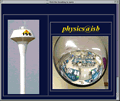Physics : Text Book
to CD
Ian Jacobs ianj@isb.ac.th
International
School Bangkok
click on any of the images to see a larger screen
shot
|
Front cover |
Main index page |
The first page of an IB extended essay |
Optical instruments index page |
![]()
When confronted with the
need for a text most of us behave like Churchill. The urge to exercise
was dealt with, on his own admission, by laying down until the feeling
passed. Feeling helpless is excusable.
Hard-copy texts are a challenge. Work away by yourself for a year or more; submit hundreds of pages of typing and a thousand diagrams and illustrations to a publisher; make his many suggested alterations and rewrites the next year; follow the whole huge edifice through the publication stages for another year. Not for the faint-hearted, or those who need the royalties. Fortunately, there is an easier way. Get a copy of DreamWeaver or GoLive up and running. Start playing with Flash. Make a small web-site with holiday pics to get yourself started.
Edit and archive your best student lab work and extended essays. Start developing animated diagrams and course content. When you have few megabytes of useful resources, burn the site on CD's for your students. Now that you've got started, have a long hard think. Build your work into a text the same way that you build a garden. Start with the structure.
Get in the earth-movers and build the walls. Decide on your structure, HTML or PDF. Decide on your color schemes and build an index structure. The current project is built in HTML in frames with scrolling text on the left. In this way the relevant illustration is always in view as the text is read. Move on to the big green stuff, the foliage. Write and illustrate course content as you teach it. Insert photographs of students and collect illustrations. Add to your growing archives on a daily basis.
Burn updates on CD's and use them with students. They will help you find the mistakes, and improve the content. Finally add the flowers. Make and add movie clips. Develop new flash movies to replace old tired illustrations. Take photographs of current students. Add new examples and current links to the web as they become available. As the years go by you will have a growing text, suited to your own style, written for your own students.
As the years go by you will have a growing text, suited to your own style, written for your own students, a cheap unique asset that is transportable. In three years we have 12,000 files; 500 megabytes and growing. Students now have access to past work as well as exam papers with answers and lesson materials. They can read what was done in previous years and plan their own lab work to add knowledge to a growing archive. They have access to models of good work, to assistance with language, to whatever we want to put in. Most importantly they have a text built around people to whom they can relate. As they build on what students like then have done, they become part of an academic community. In a small way they become scientists with a challenge to publish. It is their job to produce work that is good enough, with editing, to be added. No adult author works without the services of a professional publisher and peer review. We now provide the same services for our students.
Ian
Jacobs
Physics
International School Bangkok
www.isb.ac.th
March 2004



